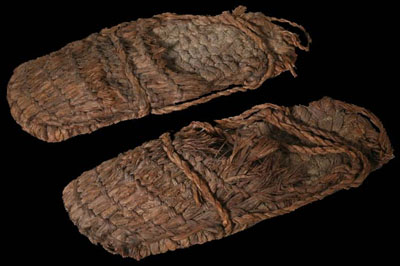14,000-year-old people poop found in cave
The discovery pushed back the date of the earliest known humans in what's now Oregon until before the end of the last ice age; scientists actually recovered DNA from the samples.
EDITOR'S NOTE: A revised, updated and expanded version of this story was published in 2016 and is recommended in preference to this older one. To read it, click here.

This pair of sagebrush sandal, found in the Fort Rock cave, is
roughly
10,000 years old. This pair is among the specimens on
display at the
UO
Museum of Cultural and Natural History.
(Image: Univ. of
Oregon) [Larger image: 1200 x 798 px]
By Finn J.D. John — November 23, 2008
When Kennewick Man was discovered, several years ago, near the bank of the Columbia River, he touched off quite a controversy. American Indian tribes, figuring he most likely was an ancestor, wanted him reburied with proper ceremony, without further disrespectful probing and testing. Scientists wanted him dissected and perhaps laid to rest in a museum someplace. And there was a fair amount of fussing over his age: At 9,300 years, he was far older than anyone expected.
It’s not completely clear, though, why anyone was surprised. Kennewick Man is not the only evidence of pre-Egyptian Pyramids life in what is now Oregon.
In the Fort Rock area, near Christmas Valley south of Bend, archaeologists found a giant pile of sagebrush sandals in 1938 — sandals that were later carbon-dated at 9,000 years old — in a cave. Actually, they almost didn't get carbon-dated at all. The archaeologist who found the footgear in '38 — Luther Cressman, a University of Oregon professor who spent a few years as Mr. Margaret Mead before their divorce was finalized — carefully treated every square millimeter with a preservative. A few years later, when the radiocarbon dating process was discovered, he was no doubt vigorously kicking himself for this: Once pickled, the shoes could not be dated. Luckily, an adventurer scrounging illegally for treasure rescued him by finding a couple scraps that he missed.
More recently, a team of scientists in 2009 — including another UO professor, Dennis Jenkins — found something of interest in the Paisley Caves of southwest Oregon. Their find pushes back knowledge of humans in Oregon even further — past the end of the last ice age, in fact. But the discovery wasn’t anything so glamorous as a skeleton or even a pair or two of ice-age sneakers. No, Dr. Jenkins & Co. found something known to science by the nice, clean, clinical term “coprolite.” And a coprolite is — or, rather, was — poop. Fossilized poop or plain old dried-out-and-left-in-a-cave-for-centuries poop, to be exact.
These hefty loads, preserved for all time by the dry air of the Paisley Caves in southeast Oregon, dated back a whopping 14,300 years — well before the earliest known peoples of the Americas 13,000 years ago, a primitive culture known as the Clovis people. And, of course, it pre-dates the end of the last Ice Age 10,000 years ago — when the massive Missoula Floods roared down the Columbia Gorge and created the flat, alluvial, silty floor of the Willamette Valley.
The scientists actually recovered DNA — 140-century-old DNA! — out of some of the, er, coprolites. The DNA determined that the party who pooped so many years ago was of Siberian or East Asian descent.
Interestingly, Jenkins and his colleagues were not plowing new ground. The Paisley Caves had been explored and identified as “one of the most important sites for Early Man in the whole West” by none other than Luther Cressman.
Luckily, it appears he left his jar of shoe preservative at home on that visit.
(Sources: Griesmann, Kate. “Dr. Dung’s Discovery,” Oregon Quarterly. Autumn 2008: 16; Sullivan, William. Hiking Oregon’s History. Eugene: Navillus, 2006.)
-30-











